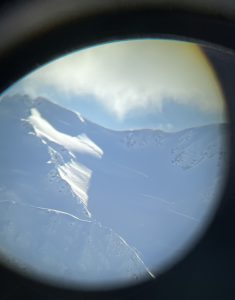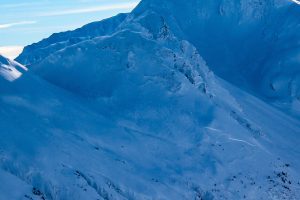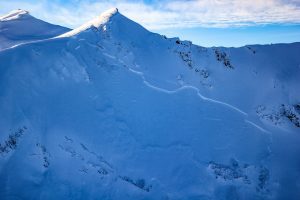Haines Avalanche Center
Above 2,500ftModerate
1,500 to 2,500ftModerate
Below 1,500ftLow
Degrees of Avalanche Danger
Avalanche Problems
Problem 1
The Bottom Line: 2-6″ of snowfall this week was redistributed by strong southeast winds, and deposited onto gullies and lee slopes above 2,500ft. These recently wind loaded areas may still be sensitive to human triggering and should be treated as suspect. We still have a few weak layers of concern in the midpack, and surface slides could step down, causing a wide and destructive avalanche. Cornices will be highly dangerous. Stay way back from any snow ledges or cornices on ridgelines or summits. Focus on avoiding convexities and cross-loaded areas, and on using the terrain to limit your exposure as a group to any slopes that could produce a slide.
Wind slabs are resting on a variety of different weak surfaces (rough, smooth, ice, melt-freeze crusts, sun crusts, sastrugi, wind slab and diurnal facets, or weak sugar snow.) Be aware of this variability of weaknesses across the landscape. Stability is highly dependent on aspect and elevation.
Practice good group management, communication and decision making. Do not ski/ride on the same slope as another group. Travel one at a time or with enough spacing so that only one person is exposed to an avalanche path.
Likelihood:
- Almost Certain
- Very Likely
- Likely
- Possible
- Unlikely
Size:
- Historic
- Very Large
- Large
- Small
Trend
- Increasing
- Steady
- Decreasing
Problem 2
Our deeper weak layers have become less reactive in snowpits, but smaller slides could still step down and trigger them, especially in steep, complex, or rocky terrain.
- Buried surface hoar from Feb 4 is sitting over the Jan 25th melt freeze crust, about ~4-5′ deep. There are also small-grained facets on this crust.
- An unlikely to trigger, but high consequence deep slab layer remains. The “Big Warm-Up layer” from Nov 17th is not to be forgotten about. Although currently dormant, a smaller slide triggered on the upper snowpack could step down and trigger this deadly beast near the ground.
Snow pit from Mar 21 in Transitonal Zone (N aspect 3400ft) showing poor structure and persistent weak layers below the 3/17 snowfall
Likelihood:
- Almost Certain
- Very Likely
- Likely
- Possible
- Unlikely
Size:
- Historic
- Very Large
- Large
- Small
Trend
- Increasing
- Steady
- Decreasing
Avalanche Activity
March 24: D2 Wet loose slides on numerous solar aspects around rocks/shallow areas all elevations
March 19-23: D3 N-aspect buns of steal near jarvis transitional zone wide propagation (click to enlarge)
D3 N-aspect Shakuseyi Peak in the lutak zone a lot of debris
Behind old faithful, D2 cross loaded NE aspect, stepped down 2ft deep. Multiple natural D2 wet/dry slides in cross loaded middle elevation slopes near town and in transitional zone.
March 16: Multiple D2 crowns in cross-loaded gullies 1-meter deep on SW-aspect near 3000ft observed in Lutak Zone.
March 7-9: Multiple D2 natural wind slab avalanches in top 45cm, on wind loaded SW, S, SE aspects in the Transitional zone, 3000-4000ft.
March 4-5: Human triggered wind slab D1/D2 at 5-mile creek Chilkat Pass, 2200ft, W aspect
D2-R4 hard slab: Mid-slope propagation, E aspect, in steep wind loaded area, unsupported slope.
D2-R4 New Faithful, W aspect, high alpine
March 2: Small natural soft slabs were observed in steep trees in the Lutak zone. This kind of small to large natural activity is likely widespread in the Lutak zone.
Feb 19-23: 6 different observations of natural avalanches in the transitional zone and in the Chilkat range. The natural D2 slides were on all aspects, a few on lower angle, all running on a mid-snow pack layer, and a majority with widespread propagation.
A larger, D3-R4 natural avalanche was observed near Four Winds on a S, SW aspect, down 60-120cm, it looked like a loose wet slide that maybe stepped down to a lower layer. Widespread propagation.
Feb 9: Glide cracks ~3000-3400′ in the transitional zone on N, NE aspects. Also notable was observation of reloading of bed surfaces on previous slides.
Jan 28: Two D2’s in the Glory Hole. NW-aspect around 3,200′
Jan 25-29th Multiple wide propagating natural slides released.
Weather
Forecast:
Mostly cloudy Saturday with light winds and some light snow possible. Temperature beginning to drop. Sunday will be colder and sunnier with moderate-strong NW winds.
Recent Weather Summary:
- March 19-23 brought light precip. with freezing levels around 2000ft and strong south winds
- March 15-16: 2-4 feet of new snow, strong south winds, and warming temperatures, snow levels reached about 2000ft.
- March 4-7 strong NW / N outflow event with cooling temps.
- March 1st brought a strong and cold storm, with 10-15″ of new snow inland, and 30″+ in the Lutak zone.
- Late Feb 20-Feb 23 a cold high pressure system with moderate to strong N, NW winds
- Feb 19-Feb 20- warmer, solar effect on south aspects, valley fog on the 19th at ~1500-2000 ft.
- Feb 12 freezing levels 1250ft
- Incremental snow (more in Lutak zone) since Feb 5th, periods of moderate S/SE winds
- Feb 1-4 Near surface facets on top of crust from Jan 25 warm-up
- Jan 17-26 brought around 5″ of precip (3-5feet of new snow above 3000ft), strong SE winds, and a noticeable warmup
- Surface Hoar and Near Surface Facet growth Jan 8-10
- A strong front brought 24-30″ of snow above 2000ft on Jan 2nd.
- There was widespread Surface Hoar growth on Dec 31st.
- Complete Season Histories: Transitional Zone Lutak Zone
| Snow Depth | Last 24-hr Snow/SWE | Last 3-days Snow/SWE | Today’s Freezing Level | Today’s Winds | Next 24-hr Snow/SWE | |
| Mount Ripinsky @ 2,500′ | 157″ | 0″ / 0.00″ | 6″ / 0.50″ | 200′ | calm, variable | 0.5″ / 0.10″ |
| Flower Mountain @ 2,500′ | 72″ | 0″ / 0.00″ | 2″ / 0.10″ | 200′ | calm, variable | 0.5″ / 0.10″ |
| Chilkat Pass @ 3,100ft | 46″ | 0″ / 0.00″ | 2″ / 0.10″ | 200′ | calm, variable | 0.5″ / 0.10″ |
Additional Information
WEAR A HELMET! Be careful of rocks and hidden hazards. Be prepared for crevasses when on a glacier.
Are your riding companions trained and practiced in avalanche rescue? Everyone in your group needs to have a beacon, shovel, and probe, and know how to use them. Our mountains have very limited cell coverage, carry an emergency communication device and enough gear to spend the night.
Avalanche Canada’s Daily Process Flow – Utilize this everyday you go out in the mountains.
Announcements
Click the +Full Forecast link below for each zone to read more. If you see any recent natural avalanche activity, or signs of instability please submit an observation. Each observation or center membership gets you entered to win prizes for the Support Raffle.






